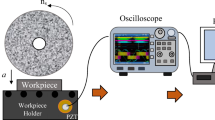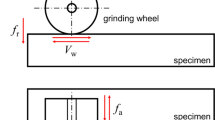Abstract
A novel method for the microcrack detection in grinding burn based on the high order strain mode was proposed in this study, which is especially suitable for the microcrack detection in small workpiece. The governing equations for solving the strain mode and the displacement mode were firstly given. With the help of the ANSYS software, the numerical modal analysis for a platelike grinding specimen without and with a microcrack was carried out. The first five order bending natural frequencies, displacement modes, and strain modes were obtained, respectively. In order to verify the effectiveness of the proposed method, the experimental modal analysis for a platelike grinding specimen without and with an artificial microcrack was performed based on the high-frequency vibrator. The results show that using the high order strain mode or increasing the number of the strain modes both can improve the accuracy of the microcrack detection. Moreover, the strain mode is more sensitive to the microcrack than the displacement mode. The findings confirm that the high order strain mode has the significant sensibility to the local structure damage and provide a possibility to establish a nondestructive detecting system for the microcrack detection.
Similar content being viewed by others
References
Malkin S, Guo C (2007) Thermal analysis of grinding. CIRP Ann Manuf Technol 56:760–782
Pavel R, Srivastava A (2007) An experimental investigation of temperatures during conventional and CBN grinding. Int J Adv Manuf Technol 33:412–418
Guo GQ, Liu ZQ, An QL, Chen M (2011) Experimental investigation on conventional grinding of Ti-6Al-4V using SiC abrasive. Int J Adv Manuf Technol 57:135–142
Pan LY, Athreya BP, Forck JA, Huang W, Zhang L, Hong T, Li WZ, Ulrich W, Mach JC (2013) Welding residual stress impact on fatigue life of a welded structure. Weld World 57:685–691
Hiroyuki S (2005) The effect on fatigue life of residual stress and surface hardness resulting from different cutting conditions of 0.45 % C steel. Int J Mach Tool Manuf 45:131–136
Ilman MN, Kusmono, Iswanto PT (2013) Fatigue crack growth rate behavior of friction-stir aluminium alloy AA2024-T3 welds under transient thermal tensioning. Mater Des 50:235–243
Pouget G, Reynolds AP (2008) Residual stress and microstructure effects on fatigue crack growth in AA2050 friction stir welds. Int J Fatigue 30:463–472
Wang Z, Willett P, DeAguiat PR, Webster J (2001) Neural network detection of grinding burn from acoustic emission. Int J Mach Tool Manuf 41:283–309
Yang ZS, Yu ZH (2013) Experimental study of burn classification and prediction using indirect method in surface grinding of AISI 1045 steel. Int J Adv Manuf Technol 68:2439–2449
Yang ZS, Yu ZH (2012) Grinding wheel wear monitoring based on wavelet analysis and support vector machine. Int J Adv Manuf Technol 62:107–121
Yang ZS, Yu ZH, Chao X, Youfang H (2014) Application of Hilbert–Huang Transform to acoustic emission signal for burn feature extraction in surface grinding process. Measurement 47:14–21
Liu Q, Chen X, Gindy N (2006) Investigation of acoustic emission signals under a simulative environment of grinding burn. Int J Mach Tool Manuf 46:284–292
Santa-aho S, Vippola M, Sorsa A, Latokartano J, Lindgren M, Leiviskä K, Lepistö T (2012) Development of Barkhausen noise calibration blocks for reliable grinding burn detection. J Mater Process Technol 212:408–416
Santa-aho S, Vippola M, Sorsa A, Lindgren M, Latokartano J, Leivisk K, Lepist T (2012) Optimized laser processing of calibration blocks for grinding burn detection with Barkhausen noise. J Mater Process Technol 212:2282–2293
Santa-aho S, Vippola M, Sorsa A, Leiviskä K, Lindgren M, Lepistö T (2012) Utilization of Barkhausen noise magnetizing sweeps for case-depth detection from hardened steel. NDT&E Int 52:95–102
Lee YS, Chung MJ (2000) A study on crack detection using eigenfrequency test data. Comput Struct 77:327–342
Khoa NV (2014) Mode shapes analysis of a cracked beam and its application for crack detection. J Sound Vib 333:848–872
Ravi D, Liew KM (2000) A study of the effect of microcrack on the vibration mode shape. Eng Struct 22:1097–1102
Yam LH, Leung TP, Li DB, Xue KZ (1996) Theoretical and experimental study of modal strain analysis. J Sound Vib 191:251–260
Østby E, Thaulow C, Akselsen OM (2012) Quantitative relation between acoustic emission signal amplitude and arrested cleavage microcrack size. Int J Fract 177:73–80
Mühlich U, Zybell L, Kuna M (2012) Estimation of material properties for linear elastic strain gradient effective media. Eur J Mech A/Solid 31:117–130
GB/T232-1988 Metallic Materials Bend Test
ASTM E 837–08 Standard test method for determining residual stresses by the hole-drilling strain-gage method.
Zhong ZW, Venkatesh VC (2009) Recent developments in grinding of advanced materials. Int J Adv Manuf Technol 41:468–480
Author information
Authors and Affiliations
Corresponding author
Rights and permissions
About this article
Cite this article
Gu, Bp., Yang, Zs. & Pan, L. Numerical modeling and experimental study of microcrack detection in grinding burn using high order strain mode. Int J Adv Manuf Technol 80, 859–870 (2015). https://doi.org/10.1007/s00170-015-7074-6
Received:
Accepted:
Published:
Issue Date:
DOI: https://doi.org/10.1007/s00170-015-7074-6




